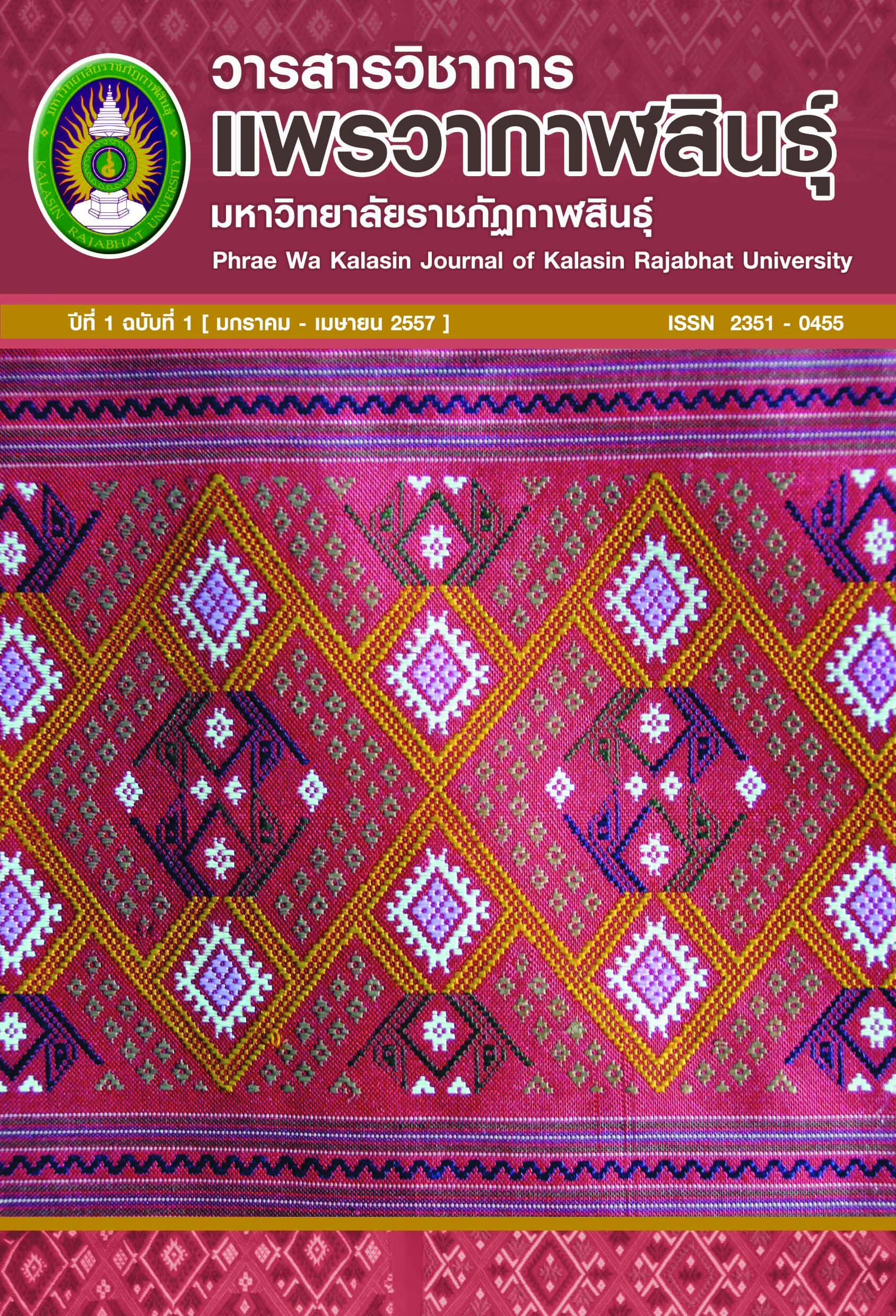ความสัมพันธ์ระหว่างแบบผู้นำกับวิธีการจัดการความขัดแย้ง ของผู้บริหารในสถานศึกษาขั้นพื้นฐาน สังกัดสำนักงานเขตพื้นที่ การศึกษาประถมศึกษากาฬสินธุ์ เขต 3 The Relationship between Leader Types and Conflict Resolution Methods of Administrators Affiliated with Ka
Main Article Content
Abstract
บทคัดย่อ
การวิจัยในครั้งนี้มีวัตถุประสงค์ เพื่อ 1) ศึกษาแบบผู้นำของผู้บริหารสถานศึกษาขั้นพื้นฐาน 2) ศึกษาวิธีการจัดการความขัดแย้งของผู้บริหารสถานศึกษาขั้นพื้นฐานและ 3) ศึกษาความสัมพันธ์ระหว่างแบบผู้นำกับวิธีการจัดการความขัดแย้งของผู้บริหารสถานศึกษาขั้นพื้นฐาน กลุ่มตัวอย่าง คือ ผู้บริหารและครูผู้สอน จำนวน 354 คนเครื่องมือที่ใช้ในการเก็บรวบรวมข้อมูล เป็นแบบสอบถามแบบมาตราส่วนประมาณค่าที่มีค่าความเชื่อมั่น 0.95 ค่าอำนาจจำแนกตั้งแต่ 0.32-0.85 สถิติที่ใช้ในการวิเคราะห์ข้อมูล คือ ร้อยละ ค่าเฉลี่ย ส่วนเบี่ยงเบนมาตรฐาน ค่าสัมประสิทธิ์สหสัมพันธ์
ผลการศึกษาพบว่า
1. ผู้บริหารในสถานศึกษาขั้นพื้นฐานสังกัดสำนักงานเขตพื้นที่การศึกษาประถมศึกษากาฬสินธุ์ เขต 3 มีพฤติกรรมการปฏิบัติเป็นผู้นำแบบนักพัฒนามากที่สุด รองลงมาคือ ผู้นำแบบผู้เผด็จการ ผู้นำแบบนักบริหาร ผู้นำแบบผู้ประนีประนอมผู้นำแบบนักบุญ
2. ผู้บริหารในสถานศึกษาขั้นพื้นฐาน สังกัดสำนักงานเขตพื้นที่การศึกษาประถมศึกษากาฬสินธุ์ เขต 3 มีการจัดการความขัดแย้งโดยรวมอยู่ในระดับมาก เมื่อพิจารณาเป็นรายด้าน พบว่า วิธีที่มีการดำเนินการมากที่สุด คือ การร่วมมือ รองลงมาคือ การประนีประนอม การยอมให้ การเอาชนะ และการหลีกเลี่ยง
3. แบบผู้นำมีความสัมพันธ์กับวิธีการจัดการความขัดแย้งของผู้บริหารสถานศึกษาขั้นพื้นฐาน สังกัดสำนักงานเขตพื้นที่การศึกษาประถมศึกษากาฬสินธุ์ เขต 3 อย่างมีนัยสำคัญทางสถิติที่ระดับ .05 และพบว่าแบบของผู้นำแต่ละแบบมีความสัมพันธ์กับวิธีการจัดการความขัดแย้งทั้งเชิงลบและเชิงบวก
คำสำคัญ: ความสัมพันธ์, แบบของผู้นำ, วิธีการจัดการความขัดแย้ง
Abstract
This research was conducted with local administrators andteachers in the primary education service area of Kalasin and had three objectives: (1) to study and rate different administrator leadership characteristics. (2) To study the rated administrator’s use of conflict resolution methods, and (3) to study the relationship between leader types and their conflict resolution methods. The sample used in the research included 354 administrators and teachers. The instrument used was a rating scale questionnaire with a reliability value of 0.95 and a discrimination index ranging from 0.32 to 0.85. Statistics were percentage, mean, standard deviation, and Pearson’s correlation coefficient. The results of this research revealed the following:
1. Most administrators in the basic education institutions affiliated with Kalasin Primary Educational Service Area Office 3 were rated as developer leaders. The remaining administrators were rated as autocratic leaders, executive leaders, compromiser leaders, and missionary leaders, respectively.
2. Overall, the administrators employed conflict resolution methods at the frequently practiced level. When considering each method, it was found that collaboration was employed most often, while compromising, accommodation, competition, and avoidance were employed respectively.
3. The leader types were significantly related to the conflict resolution methods of the administrators at the .05 level, and the relationship between leader types and conflict resolution methods was found to be both positive and negative.
Keywords: relationship, leader types, conflict resolution methods

